
Posted in: Exhibitions
 The Renwick Gallery of the Smithsonian American Art Museum’s presents the exhibit "Ginny Ruffner: Reforestation of the Imagination." Ginny Ruffner with Grant Kirkpatrick, Avem iridis illuricae (Hummingbird flower) , 2017. Installation view at MadArt Studio, 2018. Photo by and courtesy of Ruffner Studio.
The Renwick Gallery of the Smithsonian American Art Museum presents Ginny Ruffner: Reforestation of the Imagination. This innovative and truly unique artistic presentation offers visitors a glimpse into the optimistic imagination of world-renowned Seattle glass artist Ginny Ruffner.
The Renwick Gallery of the Smithsonian American Art Museum’s presents the exhibit "Ginny Ruffner: Reforestation of the Imagination." Ginny Ruffner with Grant Kirkpatrick, Avem iridis illuricae (Hummingbird flower) , 2017. Installation view at MadArt Studio, 2018. Photo by and courtesy of Ruffner Studio.
The Renwick Gallery of the Smithsonian American Art Museum presents Ginny Ruffner: Reforestation of the Imagination. This innovative and truly unique artistic presentation offers visitors a glimpse into the optimistic imagination of world-renowned Seattle glass artist Ginny Ruffner.
Imaginative Optimism
Just as a forest grows back slowly after a devastating fire, so Ginny Ruffner believes that the imagination regrows after devastating loss. Indeed, Ginny experienced such loss after a car accident stripped her of her memory. Art became her self-prescribed cure for reclaiming her identity and reforesting her own imagination. As a prelude to this show, she offers a powerful statement: "The imagination can't be exterminated. It just recreates itself." If anyone knows how true this is, it's Ginny Ruffner. Presently, many years after her accident, she offers this exhibition which demonstrates the truth of her words.Post-Apocalypse at the Renwick Gallery
Of course, all great truths must be tested in the cauldron of reality. In this case, Ginny Ruffner creates a post-apocalyptic landscape in the form of desolate landmasses strategically placed throughout the Renwick Gallery. Out of these bronze-brown lumps of earth grow transparent glass tree stumps. Something terrible has happened. The only visible life is the delicately painted shelf mushrooms growing on the sides of some of the stumps. The only other color in the exhibit comes from the painted rings on the top of each tree stump. One landmass stands central in the midst of the others. Out of the earth, emerges a large fiberglass stump. Here, the beginnings of a brand new botany sprout from the desolation. These new life forms hardly inspire optimism. Indeed, their bronze and glass appendages appear somewhat monstrous. Whatever happened here, the result speaks to a bizarre and potentially terrible new reality. However, with the help of augmented reality (AR), the scene transforms into a vibrant fantasy world, where the botanical transformation offers delightful new species of plants to please the eye.Glass Art with Augmented Reality
The "experts" told Ginny Ruffner that AR and glass would not mix. Of course, that just drove her to prove them wrong. And prove them wrong she did. Reforestation of the Imagination began with one big question she and her collaborator, Grant Kirkpatrick, aimed to answer. How can we make digital art in the form of AR work in tandem with glass so that each enhances the other? In pursuit of marrying technology with art, Ginny Ruffner went back to school to learn CGI. There she met her collaborator, Grant Kirkpatrick. Next, she used her time as an artist-in-residence at the Tacoma Glass Museum to hand blow the glass tree stumps. Augmented reality depends on pattern recognition by way of QR bar codes. Ginny learned to paint these codes into the tree rings on top of the tree stumps. In this way, the tree stumps interface with a camera to create a three-dimensional form superimposed atop each stump.Drawings & Taxonomy
With the foundation for the exhibition completed, Ginny returned to drawing. At this point, Ginny's imagination ran wild. For each plant she drew, she conceived a complete taxonomy. She explains that for quite some time she has imagined flora taking shape as a result of an alternative evolution. In addition to drawing these new plant forms in great detail, Ginny also assigned them each their own taxonomy and descriptions. For each plant represented in the Reforestation landscape, its taxonomy is included in the wall text. As a direct result of the apocalyptic conditions, these plants have combined genetically to feature unique colors and adaptations. Take for example the Musa saponifica, a relative of today's banana trees. According to Ginny, this plant grows in hot, humid regions where jungles once flourished. This unique banana plant emits a distinctive sighing sound as it exhales from an inflatable bladder. Its sole purpose in making this sound is to attract human pollinators. Loured in by the sound, humans remain transfixed as they watch one showy inflation after another. Eventually, these air bladders burst, spraying pollen all over the human observers. These people, then, carry the pollen to other locations on their clothing and feet.Something Good at the Renwick Gallery
This is only one of many reimagined plants that delight the eye in this technologically interactive exhibition at the Renwick Gallery of the Smithsonian American Art Museum. Supporting the entire exhibition is Ginny's absolute conviction that something good is always about to happen. Above all, Ginny Ruffner aims to inspire hope and provoke visitors to think deeply about the nature of life and the imagination. The exhibition remains on view until January 5, 2020. For more information, click here to visit the Renwick Gallery's website. ~Angela Magnotti Andrews5 years ago
2 view(s) 